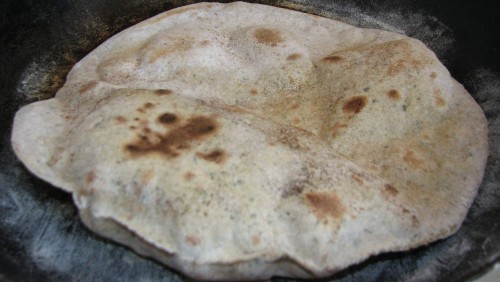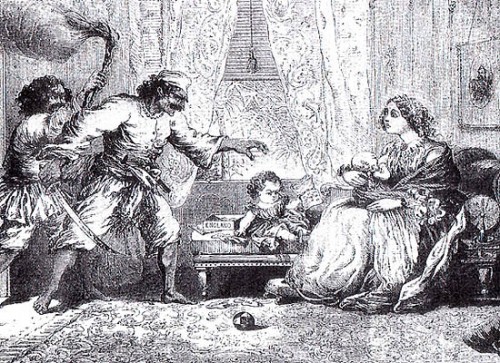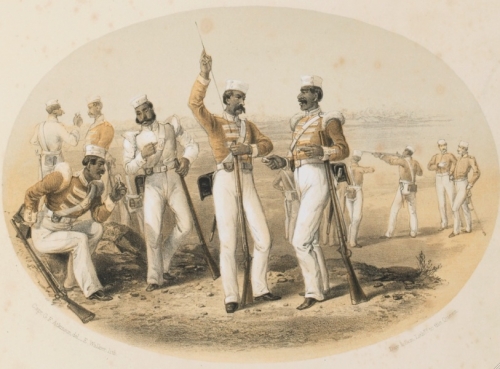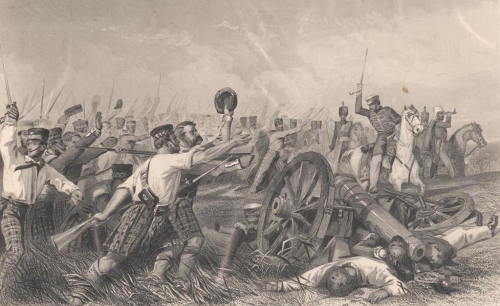The "chapatty"
FREEDOM MOVEMENT
OF INDIA
FREEDOM MOVEMENT
OF INDIA
Pass it on: The Secret that Preceded
The Indian Rebellion of 1857

The mysterious appearance of chapatis—loaves of an Indian unleavened bread—spooked the British administrators of the Raj shortly before the outbreak of rebellion in 1857.
\
“There is a most mysterious affair going on throughout the whole of India at present,” Dr. Gilbert Hadow wrote in a letter to his sister in Britain in March 1857. “No one seems to know the meaning of it.… It is not known where it originated, by whom or for what purpose, whether it is supposed to be connected to any religious ceremony or whether it has to do with some secret society. The Indian papers are full of surmises as to what it means. It is called ‘the chupatty movement.’ ”
The “movement” that Hadow was describing was a remarkable example of rumor gone wild. It consisted of the distribution of many thousands of chapatis—unleavened Indian breads—that were passed from hand to hand and from village to village throughout the mofussil (interior) of the subcontinent. The chapatis were real, but no one knew for sure what they were for. Most Indians thought they were the work of the British, who—through the East India Company —had ruled over large portions of the country for almost a century (and were, according to one well-known prophecy, due to be unseated at that century’s end). The British, who had nothing to do with the mysterious transmission, guessed the breads were a piece of mischief-making on the part of the Indians, though opinion was divided as to whether the breads came from the east, near Calcutta (Kolkata), from the north, in the province of Oude (Avadh) or from Indore, in the center of the country. Extensive inquiries into the meaning of the breads produced plenty of theories but few facts; even the runners and watchmen who baked them and carried them from village to village “did not know why they had to run through the night with chupatties in their turbans,” though they took them just the same.

India at the time of the 1857 rebellion. Click to view in higher resolution. Map: Wikicommons.
The chupatty movement first came to British attention early in February 1857. One of the first officials to encounter it was Mark Thornhill, magistrate in the little Indian town of Mathura, near Agra. Thornhill came into his office one morning to find four “dirty little cakes of the coarsest flour, about the size and thickness of a biscuit” lying on his desk. He was informed that they had been brought in by one of his Indian police officers, who had received them from a puzzled villagechowkidar (watchman). And where had the chowkidar got them? “A man had come out of the jungle with them, and given them to the watchman with instructions to make four like them and to take these to the watchman in the next village, who was to be told to do the same.”
Thornhill examined the chapatis in his office. They bore no message, and were identical to the breads cooked in every home in India, a staple part (even today) of the locals’ diet. Yet discreet inquiries soon revealed that many hundreds of chapatis were passing through his district, and through other parts of India as well—everywhere from the Narmada river in the south to the border with Nepal several hundred miles to the north. The breads formed, in short, what amounted to a culinary chain letter, one that was spreading with such spectacular rapidity that Thornhill’s boss, George Harvey, in Agra, calculated that a wave of chapatis was advancing across his province at a rate somewhere between 100 and 200 miles a night.
That rate was particularly disconcerting because it was vastly swifter than the fastest British mails, and urgent inquiries were made as to the source and meaning of the “movement.” They yielded the information that the breads were being distributed far more widely than anyone in Agra had yet realized, and that the Indians who received them generally took them as some sort of a sign. Beyond that, however, opinions remained divided.

Rumors spread with great rapidity before and during the mutiny—not least because of the large number of British women and children at the mercy of the rebels in towns such as Delhi and Kanpur.
From the North-West Provinces :
I have the honour to inform you that a signal has passed through numbers of the villages in this district, the purport of which has not yet transpired…A Chowkeydar, on receiving one of these cakes, has had five or six more prepared, and thus they have passed from village to village.… An idea has been industriously circulated that the Government has given the order.
From the interrogation of an official at the King of Delhi’s court:
I did hear of the circumstance. Some people said that it was a propitiatory observance to avert some impending calamity; others, that they were circulated by the Government to signify that the population throughout the country would be compelled to use the same food as the Christians, and thus be deprived of their religion; while others again said that the chupatties were circulated to make it known that Government was determined to force Christianity on the country by interfering with their food, and intimation of it was thus given that they might be prepared to resist the attempt.
Q. Is the sending of such articles about the country a custom among the Hindoos or Mussulmans; and would the meaning be at once understood without any accompanying explanation?A. No, it is not by any means a custom; I am 50 years old, and never heard of such a thing before.
From Delhi:
It was alluded to [in the native newspapers], and it was supposed to portend some coming disturbance, and was, moreover, understood as implying an invitation to the whole population of the country to unite for some secret objective afterwards to be disclosed.
From Awadh :
Some time in February 1857, a curious occurrence took place. A Chowkeydar ran up to another village with two chupatties. He ordered his fellow-official to make ten more, and give two to each of the five nearest village Chowkeydars with the same instructions. In a few hours the whole country was in a stir, from Chowkeydars flying around with these cakes. The signal spread in all directions with wonderful celerity. The magistrates tried to stop it, but, in spite of all they could do, it passed along to the borders of the Punjab. There is reason to believe that this was originated by some intriguers of the old Court of Lucknow.
From the confidential physician to the King of Delhi:
Nobody can tell what was the object of the distribution of the chupatties. It is not known who first projected the plan. All the people in the palace wondered what it could mean. I had no conversation with the King on the subject; but others talked in his presence about it, wondering what could be the object.

A chowkidar–an Indian village watchman. All Indian villages had one, and it was these men, running between their homes and the nearest neighboring settlement with chapatis, who so effectively raised panic among the ruling British.
Numerous explanations were considered. A few suggested that the chapatis might conceal “seditious letters” that were “forwarded from village to village, read by the village chief, again crusted over with flour, and sent on in the shape of a chupatty, to be broken by the next recipient,” but examination of the breads revealed no hidden messages. Some of the more knowledgeable British officials linked the spread of the chapatis to an effort to prevent the outbreak of cholera in central India and added that, since incidence of the disease was associated with the movement of the Company’s armies, “there was a widespread belief that the British were in fact responsible for the disease.” Another official suggested that the chupatty movement had been initiated somewhere in central India by dyers, anxious that their dyes “were not clearing properly,” or were the product of some spellwork aimed at protecting crops against hail.
All in all, the British were extremely spooked by the spread of the chapatis. Vital though their Indian empire was to them, they controlled the subcontinent with a comparative handful of men—about 100,000 in all, less than half of whom were soldiers, ruling over a population of 250 million—and they were all too aware of just how inadequate these numbers would be in the event of any serious rebellion. That, combined with a declining number of British officers who understood India, spoke Indian languages fluently or had any real sympathy for the people whom they ruled, meant that the colonial hierarchy remained perpetually jittery. Tall tales, panic and misapprehension spread readily in such a climate, and plenty of people felt a certain disquiet in the early months of 1857. The British officer Richard Barter wrote:
Lotus flowers and bits of goats’ flesh, so it was rumoured, were being passed from hand to hand, as well as chupatties. Symbols of unknown significance were chalked on the walls of towns; protective charms were on sale everywhere; an ominous slogan, Sub lal hogea hai (‘Everything has become red’) was being whispered.”

A cartridge for the new Enfield rifle. Indian soldiers in the East India Company's armies believed they risked defilement because the new rounds were being issued greased with the fat of pigs and cows–untrue, but sufficient to spark the most dangerous uprising against British imperial rule since the American Revolution.
It is no surprise, the historian Kim Wagner notes, that, faced with such a plethora of portents, “the British regarded with deep suspicion, bordering on paranoia, any type of communication in India which they could not understand.” The colonial administration well understood that rumors, however unfounded, could have serious consequences, and there were plenty of notably more dangerous urban legends about. One popular story, widely believed, suggested that the British were attempting the mass conversion of their subjects to Christianity by adulterating their flour with bone meal from cows and pigs, which was forbidden to Hindus and Moslems, respectively. Once defiled, the theory went, men who had consumed the forbidden meal would be shunned by their co-religionists and would be easier to bring into the Christian fold, or could be sent as soldiers overseas (crossing the “black water” being forbidden to Hindus of high caste). And, historically, much the same thing had happened before in times of trouble. Coconuts had passed at great speed from village to village in central India in 1818, at a time when the mofussil was being ravaged by large bands of merciless looters known as the Pindaris. Most worryingly of all, some very similar rumors had once been recorded far to the south, in the Madras Presidency in 1806, at the time of a serious outbreak of mutiny among Indian soldiersstationed at Vellore . As John Kaye wrote a few years later:
Among other wild fables, which took firm hold of the popular mind, was one to the effect that the Company’s officers had collected all the newly-manufactured salt, had divided it into two great heaps, and over one had sprinkled the blood of hogs, and over the other the blood of cows; that they had then sent it to be sold throughout the country of the pollution and desecration of the Mahommedans and Hindoos, that all might be brought to one caste and to one religion like the English.
It is not surprising that one of the many subsidiary rumors that accompanied the chupatty movement was that the breads were being carried and distributed, the eventual trial of the King of Delhi noted, “by the hands of the very lowest caste men that can be found; and the natives say that it is intended by Government to force or bribe the headmen to eat the bread, and thus loose their caste.” Hence the consumption of food supplied by the British was, notes Tapti Roy, commonly “considered as a token that they should likewise be compelled to embrace one faith, or, as they termed it, ‘One food and one faith.’ ”

Indian soldiers in the service of the East India Company-who outnumbered British troops in India five to one–loading cartridges.
By the time of the chupatty movement, no more than a handful of aged India hands could remember such long-ago events as the Vellore Mutiny. But those who did would not have been surprised by what happened next, for some very similar beliefs were spreading in the early months of 1857. A rumor that spread like wildfire among the sepoys(Indian soldiers) stationed at cantonments throughout the north of the country was that the British had come up with yet another diabolical contrivance for breaking their caste and defiling their bodies: the greased cartridge.
It was no secret that the Company’s armies had been making preparations for the introduction of a new sort of ammunition for a new model of Enfield rifle . To be loaded, this cartridge had to be torn open so that the powder it contained could be poured down the barrel of the muzzle-loading gun; because the soldier’s hands were full, this was done with the teeth. Then the bullet had to be rammed down the rifled barrel. To facilitate its passage, the cartridges were greased with tallow, which, in the U.K., was made of beef and pork fat. The greased cartridges thus posed precisely the same threat to observant sepoys as would flour adulterated with the blood of pigs and cows, and though the British recognized the problem early on, and never issued a single greased cartridge to any Indian troops, fear that the Company was plotting to defile them took hold among the men of many Indian regiments and resulted in the outbreak of rebellion in the cantonment of Meerut in April 1857.

Scottish Highlanders charge during the suppression of the rebellion of 1857.
The revolt of 1857, which the British call the Indian Mutiny but many Indians prefer to think of as the First War of Independence, was the defining event in British imperial history. It came as a greater shock than the loss of the American colonies, and prompted reprisals far more hysterical and vicious than those visited on rebellious subjects elsewhere in the Empire. In one sense, this was not surprising; since India had a large and settled British population, there were more women and children around for the rebels to kill. In another, however, the appalling atrocities visited by the Company’s armies on the people of northern India were far from justified, since the British proved to be just as prone to rumors and panics as their Indian subjects. Wild stories circulated freely in the panic-stricken atmosphere of 1857, and there were enough real massacres and murders to make almost anything seem possible. Thousands of entirely blameless Indians who found themselves caught up in the hysterical aftermath of the rebellion were flogged, or blown from cannon, or forced to clean bloodied paving stones using only their tongues before being summarily hanged.
By the time the British came to examine the causes of the rebellion, therefore, the chupatty movement had assumed a fresh significance. It was generally believed, in retrospect, that the circulation of the breads had been a warning of trouble ahead, and that the wave of chapatis must have been set in motion by a cunning group of determined conspirators who had begun plotting the rising months, if not years, in advance. The rapid spread of disorder in 1857–when regiment after regiment had mutinied, and revolts against British rule had sprung up throughout most of northern and central India–made it almost impossible to believe that the rebellion could have been spontaneous (as most modern historians concede it was), and considerable effort was made to chronicle the movement and trace the spread of the anomalous chapatis.
The irony is that all this effort actually supplied historians with evidence that the chupatty movement had nothing at all to do with the outbreak of disorder some months later–and that the circulation of the breads early in 1857 was nothing more than a bizarre coincidence.
Kim Wagner, who has made the most recent study of the phenomenon, concludes that the movement had its origins in Indore, a princely state still nominally independent of British rule, and that it began as an attempt to ward off the ravages of cholera:
The geographic circulation of the chapattis was not systematic or exponential; their transmission was erratically linear and different ‘currents’ moved at different speeds. Some currents simply ran cold, while others moved in parallel, or paused before continuing. Thus, long after the chapattis reached their northern-most point of Meerut, there was another northwards distribution from Cawnpore to Fattehgarh, which was widely reported in the newspapers… The circulation took place along well-established routes of transmission, which followed the main trade and pilgrimage routes between the bigger cities.At some point the chapattis passed beyond the limits of their meaningful transmission and simply continued through the country as a “blank” message. This allowed different meanings an interpretations to be attributed to them, and the chapattis became an index of people’s thoughts and worries.
Furthermore, the superstitious impulse that still encourages the transmission of chain letters clearly applied in 1857:
Although the original specific meaning of the chapattis had been lost early in the distribution, the dire consequences of breaking the chain of transmission remained, and thus ensured their successful circulation over an immense area. In the event, the chapattis were not ‘harbingers of a coming storm.’ They were what people made them into, and the significance attributed to them was a symptom of the pervasive distrust and general consternation amongst the Indian population during the early months of 1857.
Seen from a distance of 150 years, the chupatty movement can appear a quaint anomaly, a strange and colorful rumor of interest mostly to historians and psychologists. And yet it’s just as possible to see the bloody results of the mutual incomprehension between the British and native communities in India as a potent reminder that mistrust and panic can have serious consequences.
These are deep waters that we trawl in, and dangerous ones, too.

I really appreciate your professional approach. These are pieces of very useful information that will be of great use for me in future.
ReplyDelete